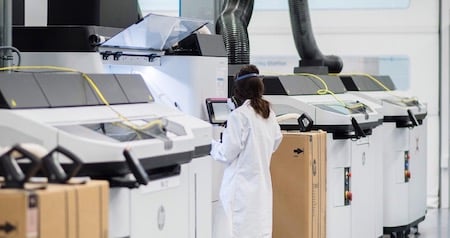The past year has brought a rapid pace of digital transformation to keep up with new consumer demands in an increasingly hybrid world, while also posing new challenges for meeting those needs due to pandemic-induced constraints.
From an increased desire to create personalized and customized products, to the development of more resilient and sustainable supply chains, we are breaking down the areas in which we anticipate additive manufacturing technology will continue to evolve in the next year in response to global trends.
The Challenge of Mass Personalization and Volume of Production
Moving into 2022, consumers are looking to invest in the latest products that are highly personalized and customized. In turn, this means traditional supply chain systems and manufacturing will no longer fit the bill. To meet growing consumer demand, we anticipate that this upcoming year will bring added focus on mass customization, enabled by digital manufacturing in industries ripe for disruption like health and wellness.
According to a Digital Manufacturing survey from HP, nine out of 10 respondents expressed that they want to explore mass customization and believe it could be applicable to their company if they could personalize parts specifically using 3D printing. As businesses explore this possibility and discover the new technologies in 3D printing and digital manufacturing that are available to them, they may experience some challenges — however the benefits will outweigh any hurdles.

As the supply chain continues to be disrupted, 3D printing offers manufacturing the ability to scale production quickly bringing resiliency to an industry with ongoing outside challenges. Image source: HP.
3D printing is an excellent and flexible solution for parts providers as companies and consumers begin to demand more personalization. As these companies recognize the significant cost implications of part inventories, traditional molds, maintenance, administration, and logistics, they are quickly able to adopt 3D printing as a viable and long-term solution for addressing some of these challenges.
With service bureaus and part providers at the frontier of these changes, they will have increased volumes of printed parts compared to traditionally manufactured parts. Not only will these businesses meet customer demands more efficiently, but they will enable resiliency in supply chains and support sustainable manufacturing efforts.
The Imperative for Supply Chain Resiliency
On the topic of additive manufacturing, it is no secret that supply chain challenges have been at an all-time high over the past two years. Industries hit hard by the pandemic have relied on digital manufacturing to become more resilient and help mitigate the supply chain disruption.
Now more than ever, resiliency and risk mitigation are not a “nice to have” but a “need to have.” 89 percent of respondents from HP’s Digital Manufacturing survey shared that they plan to evolve their business models in response to the global business environment, with over nine-in-ten investigating new supply chain models including hybrid models and localized production.
In the next year, we'll see companies consequently exploring and implementing additive-based manufacturing as a form of localized production to avoid the global supply chain disruptions— which aren't going anywhere soon. As a part of this, we anticipate 3D printing to quickly become a solution in the toolkit for building more resilient companies and disrupt traditional supply chains; in fact, 99 percent of HP’s survey respondents worldwide believe that digital manufacturing technologies like 3D printing can lead to economic growth, with more than half wanting to offer more professional training services to prepare for the implementation of 3D printing specifically.
The Future of Health Tech is Grounded in 3D Technology
Another area we expect to see 3D technology continuing to make an impact in the next year is the health and wellness sector. Through innovative, evolving technology, digital manufacturing is quickly becoming the cornerstone of the future of health technology, focused on customized patient outcomes and efficiency for health providers.

Scanning the feet of a patient using HP’s Arize Orthotic Solution, a new end-to-end digital orthotic solution developed for podiatrists and orthotists. Image source: HP.
55% of those surveyed in HP’s Digital Manufacturing report predict that in the next five years the medical industry will achieve the most innovation. We agree. Advances in tech, specifically 3D printing, have provided personalized and customized care for specific aliments, whether through customized orthotics and prosthetics, or surgical guides for pre-operation planning, and these types of innovations will only continue.
At HP we are working to usher health tech into this new era through the Arize Orthotic Solution: a new end-to-end digital orthotic solution developed for podiatrists and orthotists, announced earlier this year. Using a blend of advanced 3D printing and cloud-based software, Arize allows podiatrists and orthotists to capture 3D renderings of a patient’s foot, fine-tune and prescribe personalized orthoses for their patients in less than five minutes. We are also working with customers like SmileDirectClub in the U.S. and Impress in Europe as they continue to push the boundaries of oral care using 3D printing to manufacture highly personalized products at scale.
Sustainability is Poised to Drive Transformation in Manufacturing
Lastly, it is important to acknowledge that the pandemic has only crystallized what was already known: sustainability needs to be top of mind and conscious consumerism is a growing trend. Manufacturers have an important role in sustainability efforts, from the way they make products and develop their own supply chains, to how they package products to put on the shelves for consumers. 3D printing, and its flexible nature can power a more circular economy by creating new opportunities for sustainable disruption across industries.

There will be increased pressure on manufacturing to adapt to sustainable packaging and deploy solutions such as molded fiber and 3D printed products to reduce waste and create a circular economy. Image source: HP.
50% of respondents in HP’s Digital Manufacturing survey noted that 3D printing can reduce waste and promote a circular economy by reducing the number of materials used. In the next year there will be increased pressure on manufacturing to adapt and evolve through the deployment of innovative solutions like molded fiber packaging and 3D printed products to better promote a circular economy and reduce waste. And while we are already seeing manufacturers like Ford take that step with their new sustainability programs enabled by HP 3D printing technology, we know there is much more to come.
The Promise of Metals Manufacturing
Additive manufacturing for mass metal manufacturing is the fastest growing segment of the traditional 3D printing market. These new technologies are enabling production from high volume runs to truly unique and high value parts. The future of additive manufacturing is vast and we’re only just scratching the surface when it comes to the opportunity it provides. As discussed within this piece, one of the most demanding industries in the world, auto manufacturers, are using metal binder jetting for structural components for the first time. Alongside our partners like GNK and Parmatech, we are already seeing the benefits of new metals production from auto companies like Volkswagen to sports equipment makers like Cobra golf.

As consumers demand more personalized equipment, such as sporting equipment, manufacturers have turned to 3D printing to mass customize goods while keeping costs down and production volume up. Image source: HP.
Massive opportunities remain to grow and scale additive manufacturing and 3D printed applications, but we do know its most important value: enabling companies to meet customer demand more quickly and efficiently, while making products more personalized and sustainable.
Wayne Davey
Wayne Davey is HP’s Global Head of 3D Printing Solutions Go-to-Market.
View All Articles


Searching for more information about Product Design & Manufacturing?
Click here!